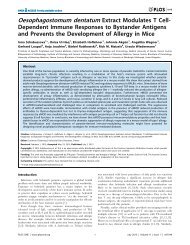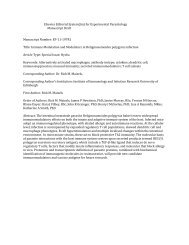Cystatins from filarial parasites - Rick Maizels' Group - University of ...
Cystatins from filarial parasites - Rick Maizels' Group - University of ...
Cystatins from filarial parasites - Rick Maizels' Group - University of ...
Create successful ePaper yourself
Turn your PDF publications into a flip-book with our unique Google optimized e-Paper software.
W.F. Gregory, R.M. Maizels / The International Journal <strong>of</strong> Biochemistry & Cell Biology 40 (2008) 1389–1398 1395<br />
enzyme AEP (Manoury et al., 2001). Furthermore, antigen<br />
processing was inhibited in whole cell assays, in<br />
which the ability <strong>of</strong> TT-pulsed B cells to stimulate<br />
TT-peptide-specific T cell clones was measured, and Bm-<br />
CPI-2 was also shown to partially inhibit invariant chain<br />
breakdown (Manoury et al., 2001). Hence, the parasite<br />
inhibitor, known to be secreted <strong>from</strong> <strong>filarial</strong> worms, can<br />
exert a direct inhibitory effect at key points in the pathway<br />
for processing <strong>of</strong> exogenous antigenic peptides to<br />
the immune system.<br />
In the mouse system, <strong>filarial</strong> cystatins have been<br />
found also to influence macrophages. In particular,<br />
nitric oxide production is significantly enhanced in<br />
IFN--activated macrophages which are exposed to<br />
Av-CPI (Av17) or Ov-CPI-2 (Hartmann, Schönemeyer,<br />
Sonnenburg, Vray, & Lucius, 2002) and this effect<br />
is independent <strong>of</strong> the LPS-responsiveness genotype <strong>of</strong><br />
the murine cells (an important control when testing<br />
recombinants derived <strong>from</strong> bacterial expression systems).<br />
Interestingly, enhancement <strong>of</strong> NO responsiveness<br />
Fig. 3. Unrooted phylogram showing the relationship <strong>of</strong> nematode cystatins with members <strong>of</strong> the cystatin, stefin and kininogen families. Numbers on<br />
top <strong>of</strong> the branch lines show the calculated credibility values. GenBank or SwissProt accession numbers are as follows: B. malayi CPI-1, P90698; B.<br />
malayi CPI-2, O16159; L. sigmodontis CPI, Q9NH95; A. viteae CPI, Q17108; O. volvulus CPI-1, Q9U9A1; O. volvulus CPI-2, P22085; N. brasiliensis<br />
CPI. Q966W0; H. contortus CPI, O44396; C. elegans CPI-1, Q9TYY2; C. elegans CPI-2, Q86S25; CST11 HUMAN, Q9H112; CST9 HUMAN,<br />
Q9H4G1; CYTA SARPE, P31727; CYTC HUMAN, P01034; CYTD HUMAN, P28325; CYTF HUMAN, O76096; CYTL DROME, P23779; CYTM<br />
HUMAN, Q15828; CYTS HUMAN, P01036; CYTT HUMAN, P09228; CYT CHICK, P01038; CYT CYPCA, P35481; CYT NAJAT, P81714;<br />
CYT ONCMY, Q91195; CYT BITAR P08935; CYT COTJA P81061; Ornithodoros moubata cystatin-1, Q6QZV5 ORNMO; Ornithodoros moubata<br />
cystatin-2, Q6QD55 ORNMO; Ixodes scapularis cystatin 2, CPIQ4PMS6 IXOSC; Ixodes scapularis CPI, Q8MVB6 IXOSC; Ixodes ricinus CPI,<br />
Q86GB6 IXORI; Hydractinia echinata CPI, CO539721; Tetraodon nigroviridis CPI, CR648555; Takifugu rubripes CPI, CA845225. Phylogenetic<br />
analysis: Cystatin sequences, omitting their signal peptides, were aligned with the aid <strong>of</strong> the ClustalW function <strong>of</strong> MacVector with final manual<br />
adjustment. The peptide sequences were analysed using the Markov chain Monte Carlo maximum likelihood process as driven by MrBayes v3.0b4.<br />
The model for amino acid substitution was not set a priori and the Markov chain randomly swapped parameters <strong>of</strong> both the trees and models. Four<br />
chains were run for 1,000,000 generations, with trees saved every 100 generations, and the Bayesian posterior probabilities for nodes in the final<br />
consensus tree derived after discarding the first 500 trees (i.e. 50,000 generations) as burn in.





